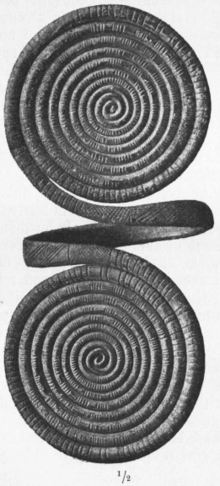Hand mountains

A hand mountain or arm mountain is a shield arm ring, a bangle with two flat spiral disks), which was particularly widespread in northern Germany in the Bronze Age . In modern specialist literature, such pieces are also referred to as hand protection spirals.
description
The arm ring consists of round or flat metal rods, the ends of which are wound horizontally into two flat spiral disks and are connected to one another by a flat and wide bracket that encompasses the wrist or arm in such a way that one spiral disk covers the knuckles of the hand and the other covers the arm. The turns of the two spirals wind up in opposite directions. On their upper side, they are usually decorated with lines, dots and lines. You can also find a variant in which only one end of the wire ends in a spiral disk, while the other end is only briefly bent.
They were found in Denmark, Pomerania, Silesia, Saxony, West Prussia and especially in Mecklenburg, the center of their distribution area. Here they are considered to be the most striking character form of the Me [c] Clenburg Bronze Age . At the beginning of the 20th century, the grand ducal collection comprised 47 specimens from graves, plus 7 from bog finds and almost 12 individual finds, making a total of 66 pieces. Similar hand protection spirals have also been found in Romania .
use
The name Handberge goes back to Hans Rudolf Schröter , the first to describe the grand-ducal Mecklenburg antiquity collection, who first used it in 1824. At this point in time the function of these pieces was still a mystery. Georg Christian Friedrich Lisch found out after all possible experiments that this device only fits one part of the body : namely , the wrist of a male body. Since then it has been assumed that the hand mountains were used to protect the outer hand, wrist and forearm against blows and against the impact of bowstrings during archery . They are inherently elastic and give way to the movements of the hand when opening and closing them in such a way that the spiral windings submit to the pressure of the knuckles and rise and fall with them. According to Lisch, they are equally suitable as jewelry and as a protective weapon .
See also
literature
- Robert Beltz: The graves of the older Bronze Age in Meklenburg: first part. In: Yearbooks of the Association for Mecklenburg History and Archeology. 67 (1902), pp. 83–196 ( full text )
- Rolf Hachmann : The early Bronze Age in the western Baltic Sea area and its Central and Southeast European relations. 1957, p. 92
- Georg Christoph Friedrich Lisch: Friderico-Francisceum or Grand Ducal Antiquities Collection from the Old Germanic and Slavic period in Meklenburg zu Ludwigslust. Leipzig: Breitkopf and Härtel, 1837, pp. 32–36
- Friedrich August Karl von Specht: History of the weapons. Volume 1, Cassel and Leipzig: Luckhardt 1870, p. 194
- Julie Schlemm: Dictionary of Prehistory. Berlin: Reimer 1908, p. 219
Individual evidence
- ↑ See the overview of the names in Mircea Petrescu-Dîmboviţa: The arm and leg jewelry in Romania. (Prehistoric bronze finds, Section 10, Volume 4) Stuttgart: Steiner 1998 ISBN 9783515067997 , p. 29
- ^ After Schlemm (lit.).
- ↑ Beltz (Lit.) p. 110.
- ↑ Beltz (Lit.) p. 111.
- ↑ Mircea Petrescu-Dîmboviţa: The arm and leg jewelry in Romania. (Prehistoric bronze finds, Section 10, Volume 4) Stuttgart: Steiner 1998, ISBN 9783515067997 , p. 29.
- ↑ According to Lisch (Lit.) <P. 33
- ↑ Lisch p. 35
- ↑ Woodpecker (lit.)